Sanyo MDF-U32V(N) Installation Manual

Instruction manual
This section is extracted and printed from Instruction Manual.
If you find out “Refer to page ” in them, this page means not page in Service manual
but page in the lower corner of each page in the extract from Instruction Manual. This page number is not corresponded with serial number in Service manual.
Please note the extracted Instruction Manual which corresponds to the initial unit
production, so the contents may be revised in future.
48
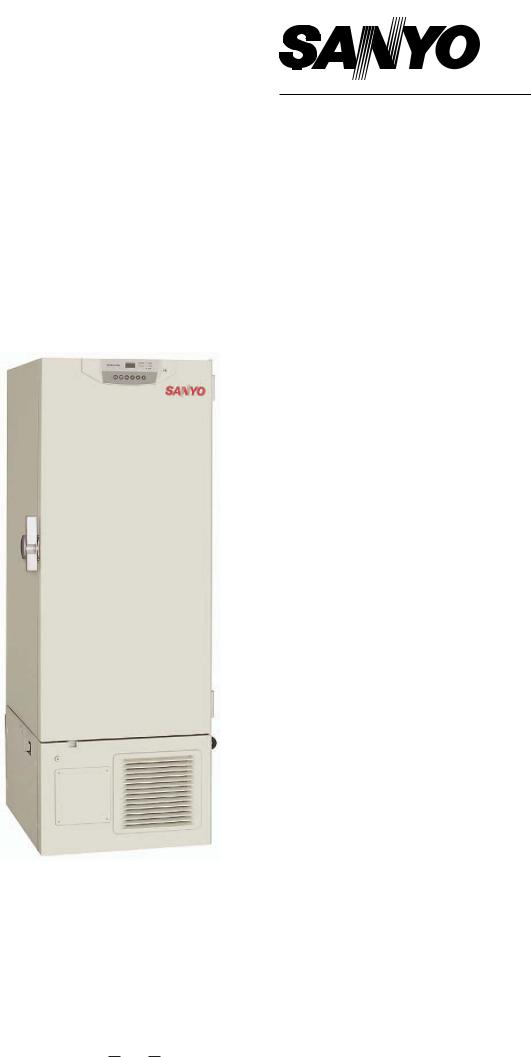
INSTRUCTION MANUAL
Ultra-Low Temperature Freezer
MDF-U33V MDF-U32V(N)
49

CONTENTS
INTRODUCTION |
P. 2 |
PRECAUTIONS FOR SAFE OPERATION |
P. 3 |
ENVIRONMENTAL CONDITIONS |
P. 7 |
FREEZER COMPONENTS |
P. 8 |
Control panel |
P.10 |
INSTALLATION SITE |
P.11 |
INSTALLATION |
P.12 |
START-UP OF UNIT |
P.13 |
TEMPERATURE SETTING |
P.14 |
Key lock function |
P.14 |
ALARM TEMPERATURE SETTING |
P.15 |
SETTING OF ALARM RESUME TIME |
P.16 |
REMOTE ALARM TERMINAL |
P.17 |
MONITOR OF FREEZER STATUS |
P.18 |
CHANGE OF COMPRESSOR DELAY TIME |
P.19 |
CHANGE OF DOOR ALARM DELAY TIME |
P.20 |
ALARMS & SAFETY FUNCTIONS |
P.21 |
ROUTINE MAINTENANCE |
|
Cleaning of cabinet |
P.22 |
Cleaning of condenser filter |
P.22 |
Defrosting of inside wall |
P.23 |
Replacement of battery |
P.23 |
TROUBLESHOOTING |
P.24 |
REPLACEMENT OF BATTERY |
P.25 |
DISPOSAL OF UNIT |
P.26 |
TEMPERATURE RECORDER[OPTION] |
P.31 |
BACK-UP SYSTEM[OPTION] |
P.33 |
INVENTORY RACK[OPTION] |
P.34 |
SPECIFICATIONS |
P.35 |
PERFORMANCE |
P.36 |
SAFETY CHECK SHEET |
P.37 |
50
1
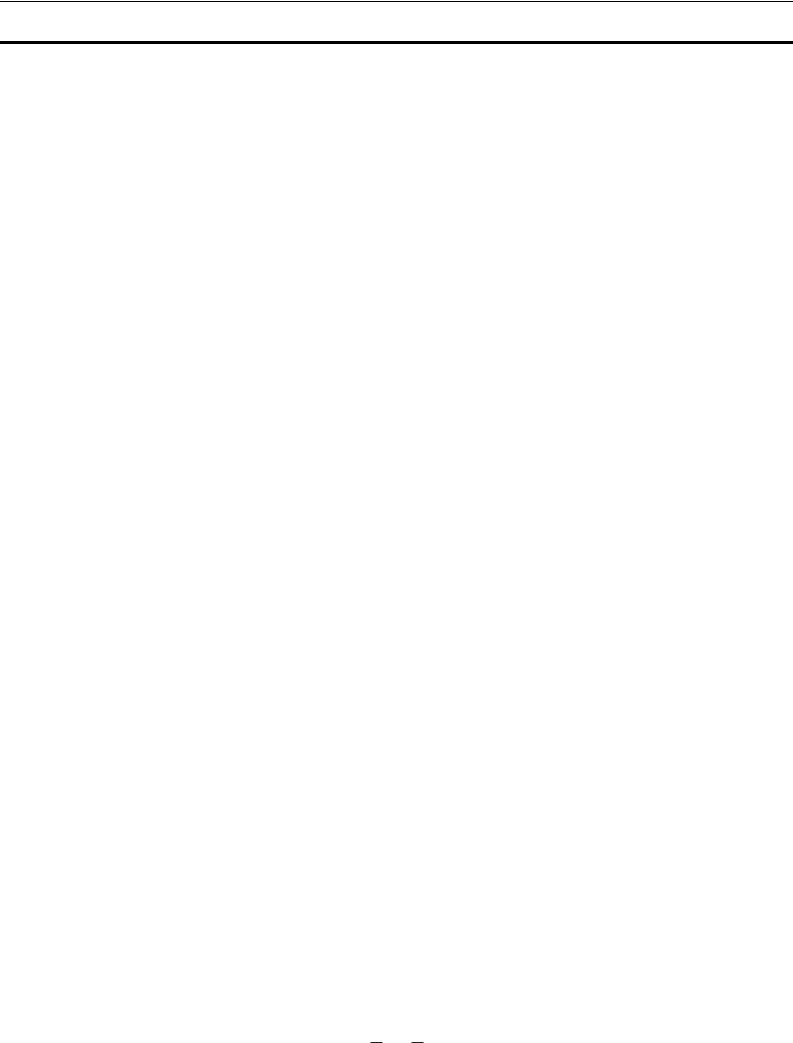
INTRODUCTION
ŶRead this manual carefully before using the appliance and follow the instructions for safety operation.
ŶSanyo never guarantee any safety if the appliance is used for any objects other than intended use or used by any procedures other than those mentioned in this manual.
ŶKeep this manual in an adequate place to refer to it as necessary.
ŶThe contents of the manual will be subjected to change without notice due to the improvement of performance or functions.
ŶContact Sanyo sales representative or agent if any page of the manual is lost or page order is incorrect.
ŶContact Sanyo sales representative or agent if any point in this manual is unclear or if there are any inaccuracies.
ŶNo part of this manual may be reproduced in any form without the expressed written permission of Sanyo.
51
2
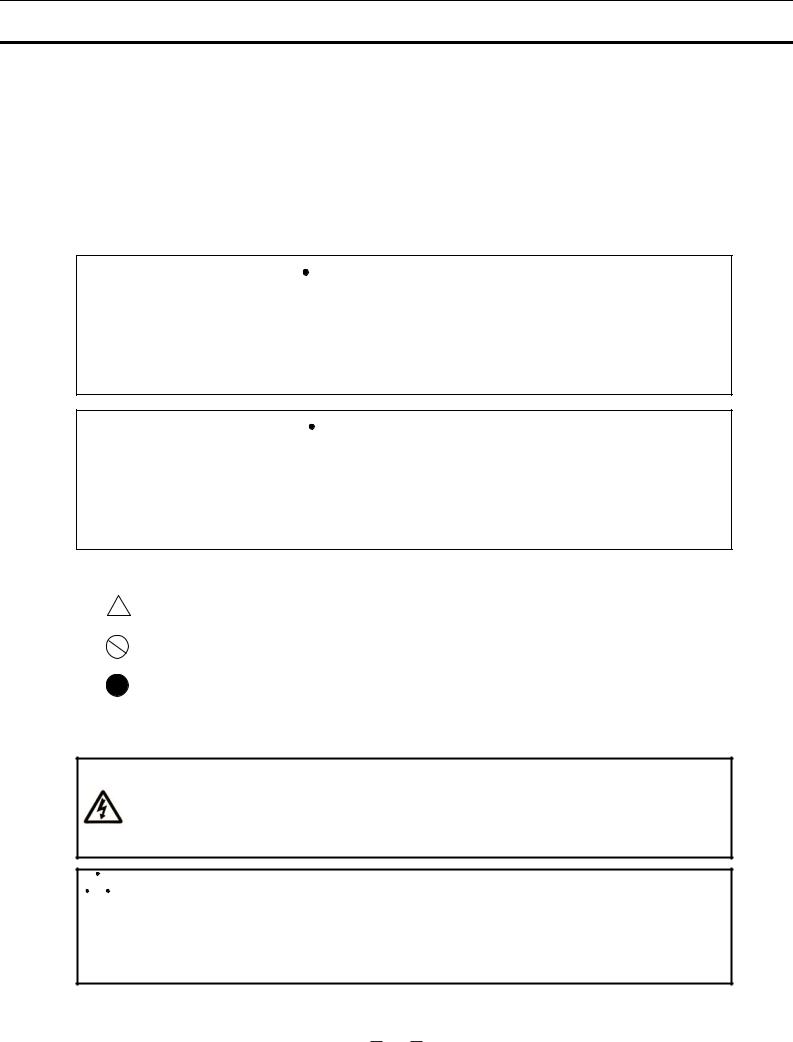
PRECAUTIONS FOR SAFE OPERATION
It is imperative that the user complies with this manual as it contains important safety advice.
Items and procedures are described so that you can use this unit correctly and safely. If the precautions advised are followed, this will prevent possible injury to the user and any other person.
Precautions are illustrated in the following way:
 WARNING
WARNING
Failure to observe WARNING signs could result in a hazard to personnel possibly resulting in serious injury or death.
 CAUTION
CAUTION
Failure to observe CAUTION signs could result in injury to personnel and damage to the unit and associated property.
Symbol shows;
this symbol means caution.
this symbol means an action is prohibited.
this symbol means an instruction must be followed.
Be sure to keep this manual in a place accessible to users of this unit.
< Label on the unit >
This mark is labeled on the cover in which the electrical components of high voltage are enclosed to prevent the electric shock.
The cover should be removed by a qualified engineer or a service personnel only.
 WARNING
WARNING
As with any equipment that uses CO2 gas, there is a likelihood of oxygen depletion in the vicinity of the equipment. It is important that you assess the work site to ensure there is suitable and sufficient ventilation. If restricted ventilation is suspected, then other methods of ensuring a safe environment must be considered. These may include atmosphere monitoring and warning devices.
52
3
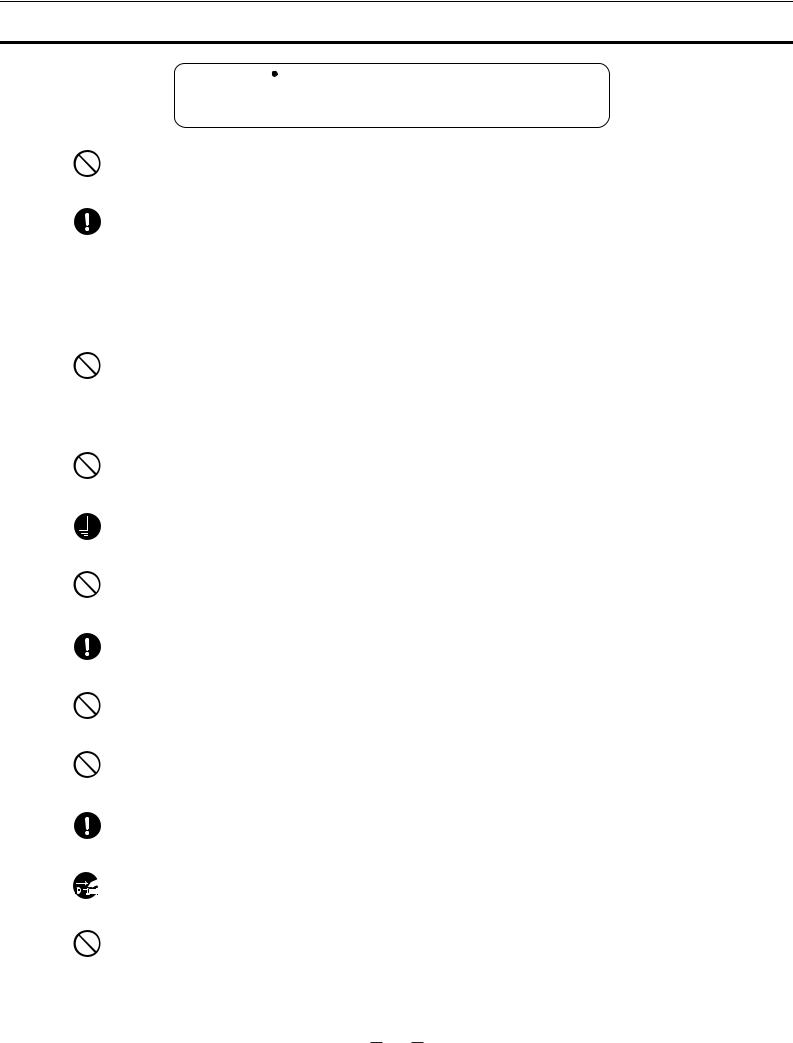
PRECAUTIONS FOR SAFE OPERATION
 WARNING
WARNING
Do not use the unit outdoors. Current leakage or electric shock may result if the unit is exposed to
rain water.
Only qualified engineers or service personnel should install the unit. The installation by
unqualified personnel may cause electric shock or fire.
Install the unit on a sturdy floor and take an adequate precaution to prevent the unit from  turning over. If the floor is not strong enough or the installation site is not adequate, this may result
turning over. If the floor is not strong enough or the installation site is not adequate, this may result
in injury from the unit falling or tipping over.
Never install the unit in a humid place or a place where it is likely to be splashed by water.
Deterioration of the insulation may result which could cause current leakage or electric shock.
 Never install the unit in a flammable or volatile location. This may cause explosion or fire.
Never install the unit in a flammable or volatile location. This may cause explosion or fire.
Never install the unit where acid or corrosive gases are present as current leakage or electric
shock may result due to corrosion.
Always ground (earth) the unit to prevent electric shock. If the power supply outlet is not grounded, it will be necessary to install a ground by qualified engineers.
Never ground the unit through a gas pipe, water main, telephone line or lightning rod. Such
grounding may cause electric shock in the case of an incomplete circuit.
Connect the unit to a power source as indicated on the rating label attached to the unit. Use
of any other voltage or frequency other than that on the rating label may cause fire or electric shock.
Never store volatile or flammable substances in this unit if the container cannot be sealed. These
may cause explosion or fire.
Do not insert metal objects such as a pin or a wire into any vent, gap or any outlet on the unit.
This may cause electric shock or injury by accidental contact with moving parts.
Use this unit in safe area when treating the poison, harmful or radiate articles. Improper use
may cause bad effect on your health or environment.
Turn off the power switch (if provided) and disconnect the power supply to the unit prior to any 

 repair or maintenance of the unit in order to prevent electric shock or injury.
repair or maintenance of the unit in order to prevent electric shock or injury.
Do not touch any electrical parts (such as power supply plug) or operate switches with a wet hand. This may cause electric shock.
53
4
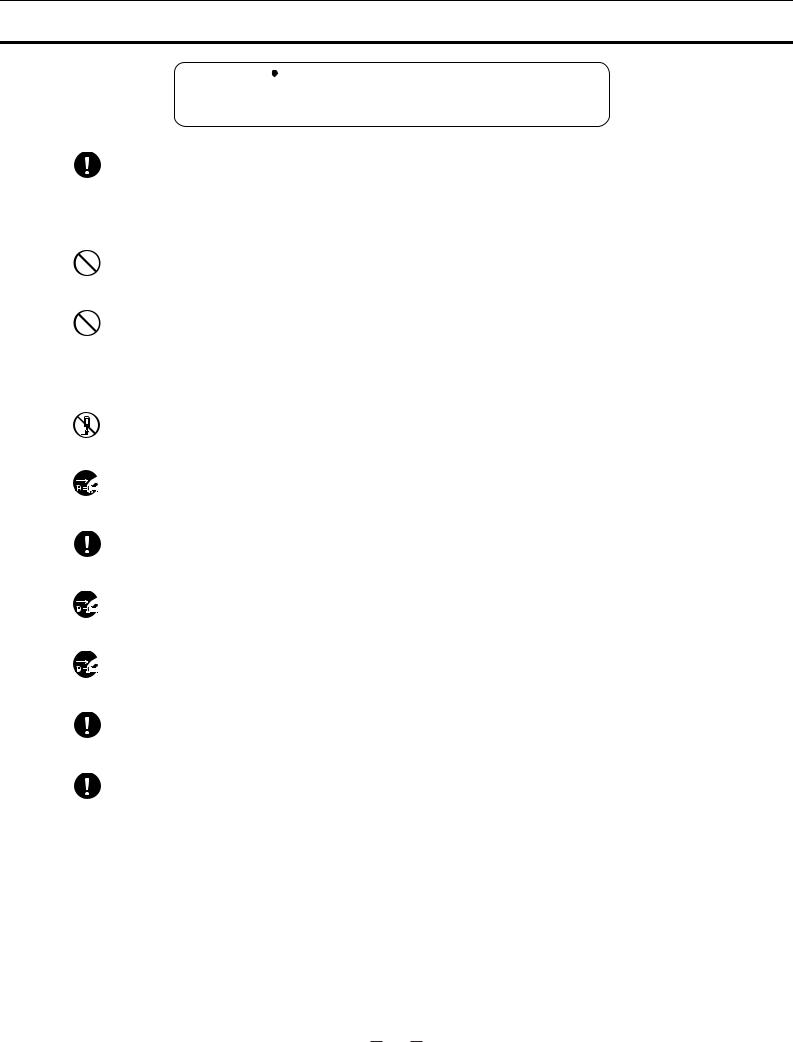
PRECAUTIONS FOR SAFE OPERATION
 WARNING
WARNING
Ensure you do not inhale or consume medication or aerosols from around the unit at the time of maintenance. These may be harmful to your health.
 Never splash water directly onto the unit as this may cause electric shock or short circuit.
Never splash water directly onto the unit as this may cause electric shock or short circuit.
Never put containers with liquid on the unit as this may cause electric shock or short circuit when
the liquid is spilled.
Never bind, process, or step on the power supply cord, or never damage or break the power supply plug. A broken supply cord or plug may cause fire or electric shock.
 Do not use the supply cord if its plug is loose. Such supply cord may cause fire or electric shock.
Do not use the supply cord if its plug is loose. Such supply cord may cause fire or electric shock.
Never disassemble, repair, or modify the unit yourself. Any such work carried out by an unauthorized person may result in fire, or electric shock or injury due to a malfunction.
Disconnect the power supply plug if there is something wrong with the unit. Continued
abnormal operation may cause electric shock or fire. |
When removing the plug from the power supply outlet, grip the power supply plug, not the cord. Pulling the cord may result in electric shock or fire by short circuit.
Disconnect the power supply plug before moving the unit. Take care not to damage the power 

 cord. A damaged cord may cause electric shock or fire.
cord. A damaged cord may cause electric shock or fire.
Disconnect the power plug when the unit is not used for long periods. Keeping the connection 

 may cause electric shock, current leakage, or fire due to the deterioration of insulation.
may cause electric shock, current leakage, or fire due to the deterioration of insulation.
If the unit is to be stored unused in an unsupervised area for an extended period, ensure that
children do not have access and that doors cannot be closed completely.
The disposal of the unit should be accomplished by appropriate personnel. Remove doors to
prevent accidents such as suffocation.
 Do not put the packing plastic bag within reach of children as suffocation may result.
Do not put the packing plastic bag within reach of children as suffocation may result.
54
5

PRECAUTIONS FOR SAFE OPERATION
 CAUTION
CAUTION
Use a dedicated power source (a dedicated circuit with a breaker) as indicated on the rating label
attached to the unit. A branched circuit may cause fire resulting from abnormal heating.
Connect the power supply plug to the power source firmly after removing the dust on the plug.
A dusty plug or improper insertion may cause a heat or ignition.
Never store corrosive substances such as acid or alkali in this unit if the container cannot be
sealed. These may cause corrosion of inner components or electric parts.
Check the setting when starting up of operation after power failure or turning off of power
switch. The stored items may be damaged due to the change of setting.
 Be careful not to tip over the unit during movement to prevent damage or injury.
Be careful not to tip over the unit during movement to prevent damage or injury.
Prepare a safety check sheet when you request any repair or maintenance for the safety of service personnel.
55
6

ENVIRONMENTAL CONDITIONS
This equipment is designed to be safe at least under the following conditions (based on the IEC 61010-1):
ŶIndoor use;
ŶAltitude up to 2000 m;
ŶAmbient temperature 5oC to 40oC
ŶMaximum relative humidity 80% for temperature up to 31oC decreasing linearly to 50% relative humidity at 40oC;
Ŷ Mains supply voltage fluctuations not to exceed 10% of the nominal voltage;
ŶOther supply voltage fluctuations as stated by the manufacturer;
ŶTransient overvoltages according to Installation Categories (Overvoltage Categories) II; For mains supply the minimum and normal category is II;
ŶPollution degree 2 in accordance with IEC 60664.
56
7
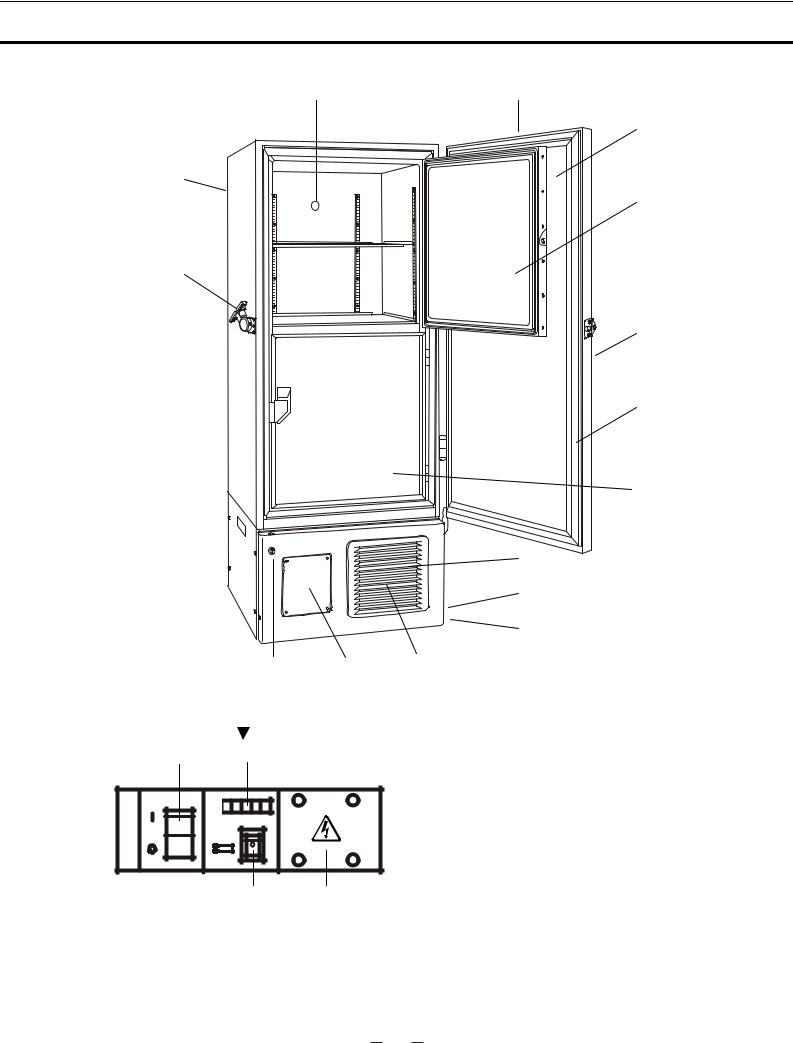
FREEZER COMPONENTS
5 |
8 |
1
11
6
3
2
4
5 (inside)
12
9
10
7 |
14 |
15 (inside) |
|
|
|
13 17
16 18
57
8
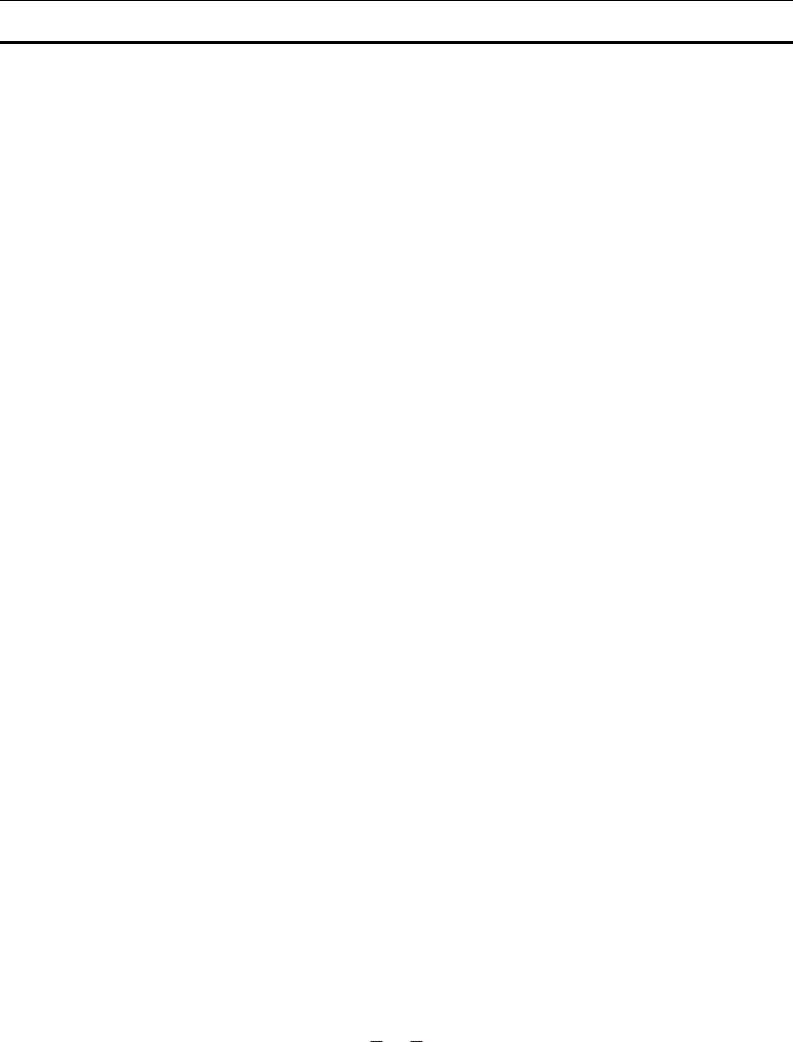
FREEZER COMPONENTS
1.Outer door: To open the door, grip the handle. On closing, lock the door latch completely.
2.Handle: Always grip this handle to open and close the outer door.
3.Door latch: Always lock the latch when the outer door is closed.
4.Magnetic door gasket: This provides a tight door seal and prevents cold air leak. Keep clean.
5.Access port (back and bottom): This is used for leading a cable and sensor of a measuring equipment, or nozzle of back-up system to chamber.
6.Inner door: The operation of the inner door should be quick to minimize the temperature rise in chamber. Lock the door latch completely when the door is closed. The door is removable for cleaning or defrosting. See page 22 “Routine maintenance”.
7.Lock: Turn clockwise to 180o with a key and the outer door is securely locked.
8.Control panel (on the upper front of the door): Used for temperature setting and indication of operating status is displayed on the panel. See page 10 for details.
9.Caster: 4 casters are provided to facilitate moving of the cabinet. For the installation, adjust the leveling foot so that the front 2 casters cannot contact with the floor.
10.Leveling foot: The height of the freezer can be adjusted by this screw type foot. Keep the unit in level at the installation.
11.Fixture (on back side): 2 fixtures are provided as spacers between the cabinet and wall and also serve as hooks to fix the unit. See page 12 “Installation”.
12.Air intake vent (grille): Do not block this vent to keep the proper cooling performance.
13.Power switch: This is for turning ON/OFF the power to the unit. ON – “I” OFF – “○”
14.Space for temperature recorder: An automatic temperature recorder (optional component) can be attached here. See page 31 “Temperature recorder”.
15.Condenser filter (behind the grille): This filter prevents the dust from accumulating on the condenser. The dusty filter may cause failure of refrigerating device. Clean the filter once a month. See page 22 “Routine maintenance” for the cleaning.
16.Battery switch: This is a switch for a battery for power failure alarm. Normally, turn on this switch. Be sure to turn off this switch if the freezer is not in operating for the long period (over one month).
17.Remote alarm terminal: This is used to notice an alarm condition of the unit to remote location. Refer to page 17 “Remote alarm terminal”.
18.Space for optional component:
58
9
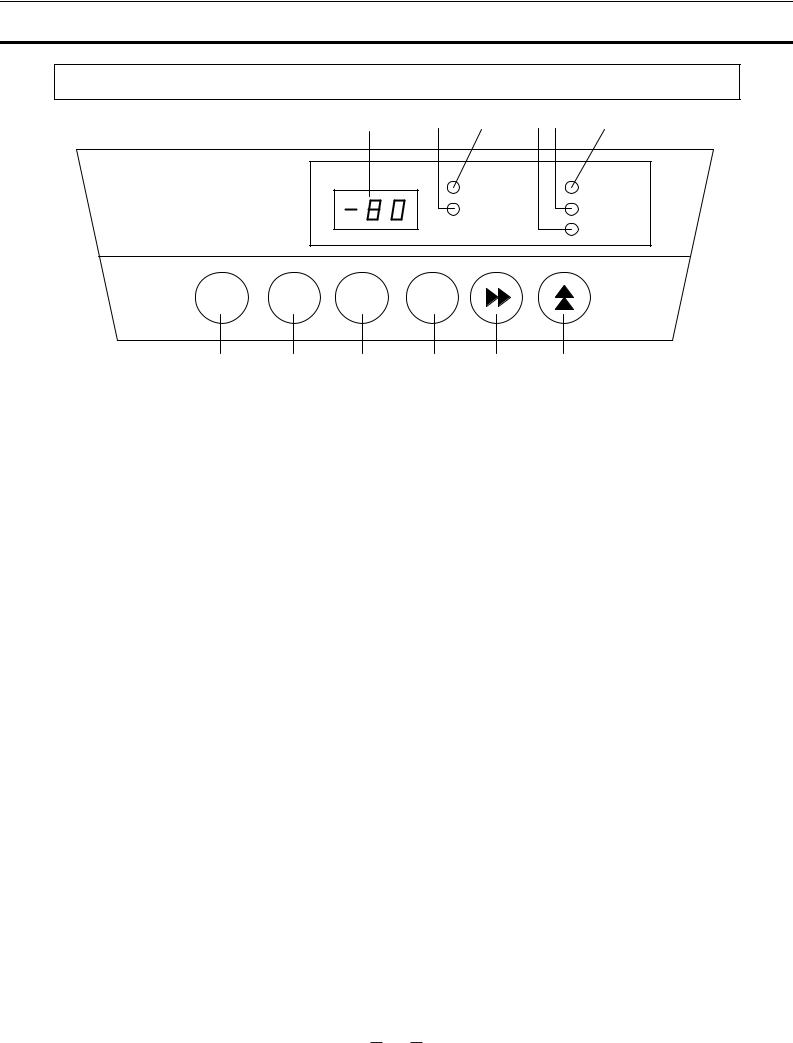
FREEZER COMPONENTS
Control panel
5 |
11 |
10 |
8 |
6 |
9 |
TEMPERATURE |
|
BATTERY |
|
|
FILTER |
ULTRA LOW |
|
|
|
||
|
STATUS |
|
|
ALARM |
|
|
|
|
|
||
|
|
|
|
|
DOOR |
BUZZER |
ALARM |
STATUS |
SET |
|
TEST |
||||
|
|
|
1 7 12 2 3 4
1.Buzzer stop key (BUZZER): To silence the audible alarm under alarm condition, press this key. The buzzer during alarm test cannot be silenced by this key.
2.Set key (SET): Temperature setting mode is led by pressing this key and the changeable digit is flashed. By pressing this key again, the setting is memorized. The set mode returns to the temperature display mode automatically when 90 seconds has passed without any key operation. Refer to page 14 for details.
3.Digit shift key (  ): Pressing this key in the setting mode causes the changeable digit to shift. Key lock is available by pressing this key for more than 5 seconds in the temperature display mode. Refer to page 14 for details.
): Pressing this key in the setting mode causes the changeable digit to shift. Key lock is available by pressing this key for more than 5 seconds in the temperature display mode. Refer to page 14 for details.
4.Numerical value shift key (  ): Pressing this key in the setting mode causes the numerical value to shift. “ON-OFF” of key lock can be selected by pressing this key in the key lock mode. By pressing this key for more than 5 seconds in the temperature display mode leads setting mode for alarm temperature and alarm resume time. Refer to page 15 and 16 for details respectively.
): Pressing this key in the setting mode causes the numerical value to shift. “ON-OFF” of key lock can be selected by pressing this key in the key lock mode. By pressing this key for more than 5 seconds in the temperature display mode leads setting mode for alarm temperature and alarm resume time. Refer to page 15 and 16 for details respectively.
5.Digital temperature indicator: This indicator shows the present chamber temperature or set temperature.
6.Alarm lamp (ALARM): This lamp is flashed during alarm condition.
7.Alarm test key (ALARM TEST): To check the alarm system during freezer operation. Pressing this key with the battery switch ON gets the alarm lamp to flash, the remote alarm to operate, and the buzzer to sound.
8.Door check lamp (DOOR): This lamp lights when the door is open.
9.Filter check lamp (FILTER): This lamp lights when the excessive dust is accumulated on the condenser filter. When this lamp lights, clean the condenser filter following the procedure on page 22.
10.Battery check lamp (BATTERY): This lamp flickers to recommend the battery replacement. For the replacement, consult Sanyo sales representative or agent.
11.Status monitor lamp (STATUS): This lamp lights when environmental condition or status gets worse or the unit is out of normal operation.
12.Status key (STATUS): By pressing this key in the event of the status monitor lamp ON, the status code is displayed on the temperature indicator. This key is not effective when the freezer is running normally. See page 18 for details.
59
10
